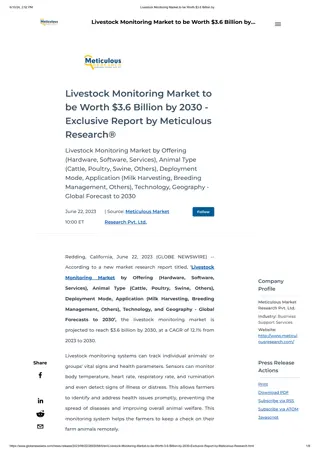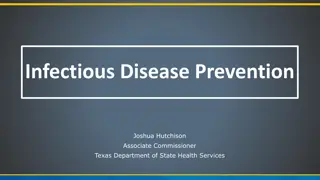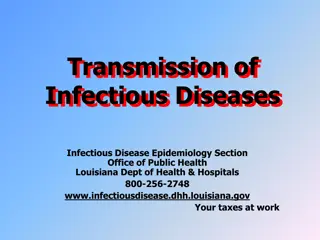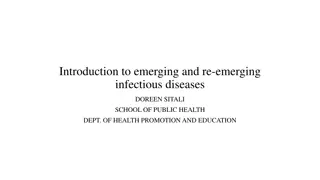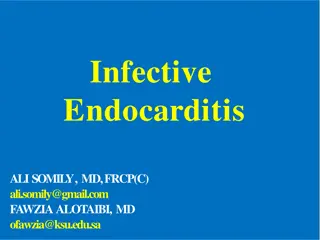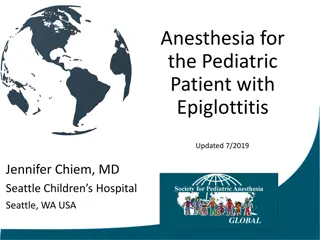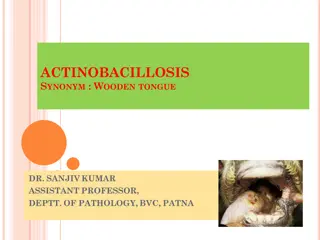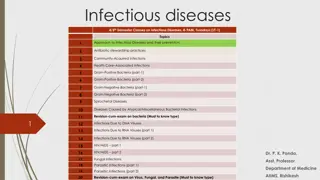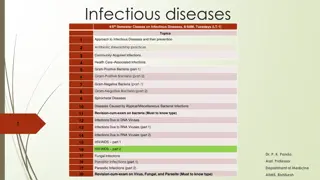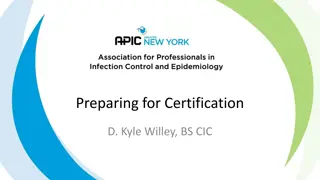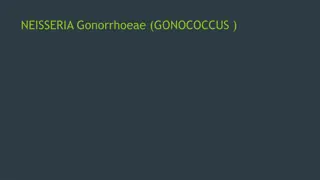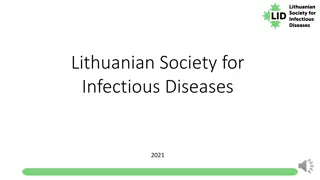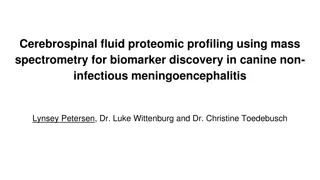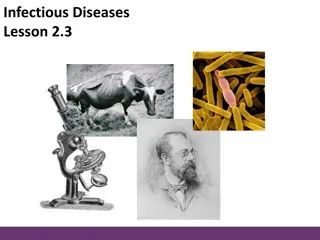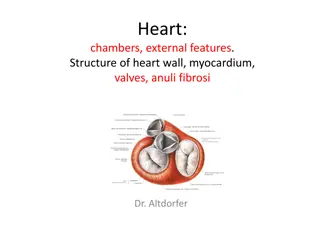Infectious Endocarditis
A 22-year-old female patient with a history of infected endocarditis and recent dental procedure presents with high-grade fever, chills, shortness of breath, and arthralgia. Examination reveals a pan systolic murmur and tachycardia. Echocardiography shows mitral regurgitation with vegetation on the valve.
Download Presentation

Please find below an Image/Link to download the presentation.
The content on the website is provided AS IS for your information and personal use only. It may not be sold, licensed, or shared on other websites without obtaining consent from the author. Download presentation by click this link. If you encounter any issues during the download, it is possible that the publisher has removed the file from their server.
E N D
Presentation Transcript
Dr. Zak Bettamer Zikoecho@yahoo.com
22 years old female patient with previous history of infected endocarditis before and recent dental procedure admitted to the hospital with history of High grade fever and chills, Shortness Of Breath Arthralgia 3 days duration . On Examination BP: 100/70, Pulse : 110 beat/minute, Temperature : 40 C Cardiovascular examination : pan systolic Murmur and tachycardia. Chest : clear Abdominal Examination : Normal White Blood Cells is high and ECG show Sinus Tachycardia. Echocardiography show Mitral regurgitation with Vegetation on top of the Mitral Valve.
Infectious Endocarditis (IE): an infection of the heart s endocardial surface Classified into: Native Valve IE Prosthetic Valve IE
1. Turbulent blood flow disrupts the endocardium making it sticky 2. Bacteremia delivers the organisms to the endocardial surface 3. Adherence of the organisms to the endocardial surface 4. Eventual invasion of the valvular leaflets
Incidence difficult to ascertain and varies according to location Much more common in males than in females May occur in persons of any age and increasingly common in elderly Mortality ranges from 20-30% Icidence: 2 -5 caese/ 100 000.
Intravenous drug abuse Artificial heart valves and pacemakers Acquired heart defects Calcific aortic stenosis Mitral valve prolapse with regurgitation Congenital heart defects Intravascular catheters
Common bacteria S. aureus Streptococci Enterococci Not so common bacteria Fungi Pseudomonas
Acute Subacute Low grade fever Anorexia Weight loss Fatigue Arthralgias/ myalgias Abdominal pain N/V High grade fever and chills SOB Arthralgias/myalgias Abdominal pain Pleuritic chest pain Back pain The onset of symptoms is usually 2 weeks or less from the initiating bacteremia
Fever Heart murmur Nonspecific signs petechiae, subungal or splinter hemorrhages, clubbing, splenomegaly, neurologic changes More specific signs - Osler s Nodes, Janeway lesions, and Roth Spots
1.Nonspecific 2.Often located on extremities or mucous membranes
1. Nonspecific 2. Nonblanching 3. Linear reddish-brown lesions found under the nail bed 4. Usually do NOT extend the entire length of the nail
1. More specific 2. Painful and erythematous nodules 3. Located on pulp of fingers and toes 4. More common in subacute IE
1. More specific 2. Erythematous, blanching macules 3. Painless. 4. Located on palms and soles
Blood Cultures Minimum of three blood cultures Three separate venipuncture sites Obtain 10-20 mL in adults and 0.5-5 mL in children Positive Result Typical organisms present in at least 2 separate samples Persistently positive blood culture (atypical organisms) Two positive blood cultures obtained at least 12 hours apart Three or a more positive blood cultures in which the first and last samples were collected at least one hour apart
CBC ESR and CRP Complement levels (C3, C4, CH50) Rhematoid factor. Urinalysis: microscopic hematuria. Baseline chemistries and coags
Chest x-ray Look for multiple focal infiltrates and calcification of heart valves ECG Rarely diagnostic Look for evidence of ischemia, conduction delay, and arrhythmias Echocardiography
Transthoracic echocardiography (TTE) First line if suspected IE Native valves Transesophageal echocardiography (TEE) Prosthetic valves Intracardiac complications Inadequate TTE Fungal or S. aureus or bacteremia
Definitive diagnosis: 2 major 1 major and 3 minor criteria. All 5 minor criteria. Major criteria: Positive blood culture. Endocardium involved: +ve Echo (vegatation, abcess). New valvular regurgitation.
Minor criteria: Predisposition (cardiac lesion, IV drug abuser). Fever >38 Vascular/ immunological signs. +ve blood culture that do not meet major criteria. +ve Echo that doesn t meet major criteria.
Parenteral antibiotics High serum concentrations to penetrate vegetations Prolonged treatment to kill dormant bacteria clustered in vegetations - Acute: flucloxacillin and gentamicin . - Subacute : benzyl penicillin and gentamicin . - penicillin allergy, a prosthetic valve or suspected meticillin-resistant Staph. aureus (MRSA) infection, triple therapy with vancomycin, gentamicinnand oral rifampicin should be considered Surgery Intracardiac complications Surveillance blood cultures
Heart failure due to valve damage Failure of antibiotic therapy (persistent/uncontrolled infection) Large vegetations on left-sided heart valves with evidence or high risk of systemic emboli Abscess formation *Patients with prosthetic valve endocarditis or fungal endocarditis often require cardiac surgery.
Four etiologies Embolic Local spread of infection Metastatic spread of infection Formation of immune complexes glomerulonephritis and arthritis
Occur in up to 40% of patients with IE Incidence decreases significantly after initiation of effective antibiotics Stroke Myocardial Infarction Ischemic limbs Hypoxia from pulmonary emboli Abdominal pain (splenic or renal infarction)
Heart failure Extensive valvular damage Paravalvular abscess (30-40%) Most common in aortic valve, IVDA, and S. aureus May extend into adjacent conduction tissue causing arrythmias Higher rates of embolization and mortality Pericarditis Fistulous intracardiac connections
Acute S. aureus IE with perforation of the aortic valve and aortic valve vegetations. Acute S. aureus IE with mitral valve ring abscess extending into myocardium.
Metastatic abscess Kidneys, spleen, brain, soft tissues Meningitis and/or encephalitis Vertebral osteomyelitis Septic arthritis
Which condition? Heart transplantation Cyanotic congenital Heart Disease Prosthetic Valve Previous History of IE
Until recently, antibiotic prophylaxis was routinely given to people at risk of infective endocarditis undergoing interventional procedures. However, as this has not been proven to be effective and the link between episodes of infective endocarditis and interventional procedures has not been demonstrated, antibiotic prophylaxis is no longer offered routinely for defined interventional procedures.
Dental procedures involving extractions, scaling, polishing or gingival surgery. Upper respiratory tract surgery. Esophageal dilatation. Surgery of lower bowel, gall bladder, or GU tract.
Local or no anesthesia: Amoxycillin 3 g orally 1 hour before. If allergic to peniciilin Clindamycin 600 mg. General anesthesia, no special risk: Amoxycillin 1 g I.V. at induction, followed by 500 mg 6 hours later. Gn. Anesthesia, special risk (prosthetic valve, previous I.E):Amoxycillin IV 1 g + gentamacin 120 mg at induction, followed by 500 mg amoxycillin 6 hours later. If allergic to peniciliin: IV vancomycin or clindamycin.




